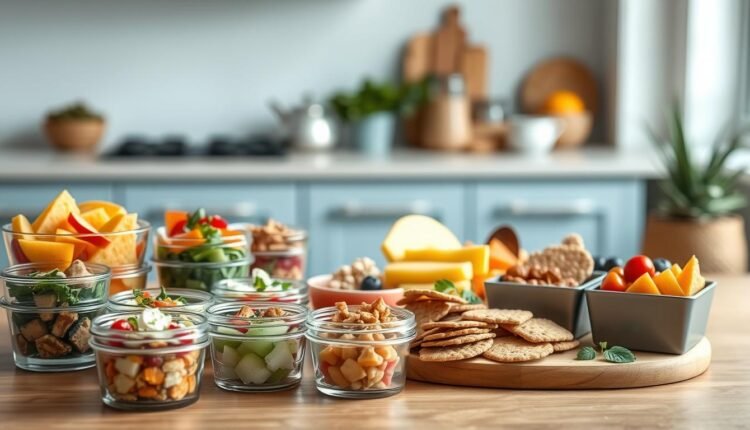No Heat Lunchbox Meals Mediterranean Style For Health
Discover simple no heat lunchbox meals mediterranean style for a healthy meal prep. Get our top picks for easy, grab-and-go lunches.
Did you know meals inspired by the Mediterranean coast can boost heart health even when served cold? As a chef juggling family meals and recipe testing, I’ve learned that vibrant flavors and smart prep turn simple ingredients into lunchbox magic. Think marinated chickpeas, crisp veggies, and tangy feta—all packed to stay fresh without reheating.
This approach isn’t just about convenience. Studies show Mediterranean-inspired eating patterns support lower inflammation and better energy levels. The secret? Combining lean proteins, whole grains, and olive oil-based dressings that hold up beautifully in your container. You’ll find creative Mediterranean-inspired lunch ideas require less effort than you’d expect, with big rewards for your afternoon focus.
Quick highlights:
- Flavor-packed lunches ready straight from the fridge
- Smart combos of healthy fats, fiber, and plant proteins
- Prep-friendly formulas that adapt to what’s in your pantry
No Heat Mediterranean Lunches
Imagine opening your midday container to bright colors and crisp textures that taste like sunshine. This is the magic of Mediterranean-inspired dishes designed for room-temperature enjoyment. As a chef balancing family needs and recipe development, I’ve found these vibrant combinations solve two problems: avoiding soggy leftovers and keeping energy levels steady.
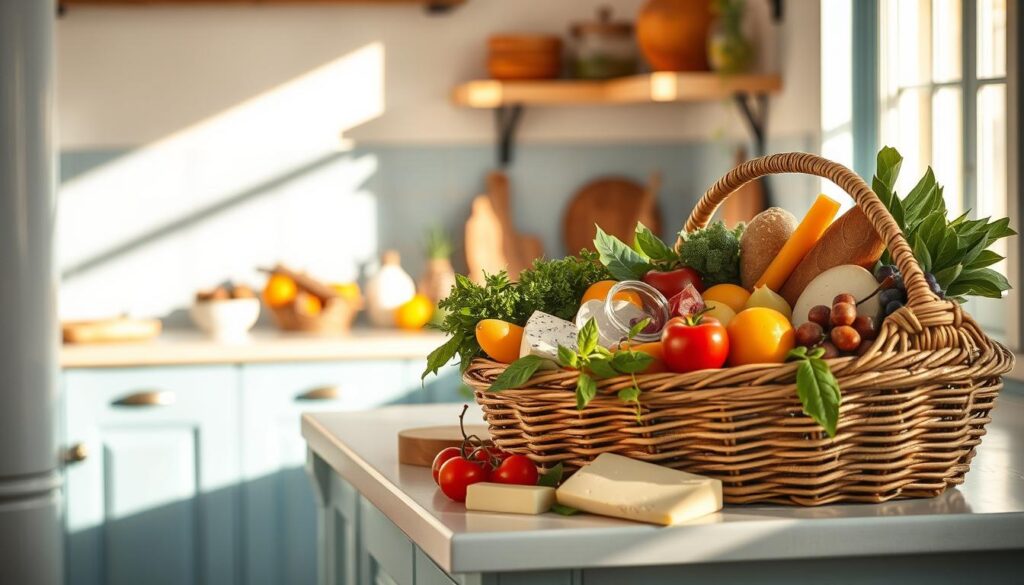
A Fresh Culinary Perspective
Traditional packed food often sacrifices flavor for convenience. Not here. Think marinated artichokes mingling with pearl couscous, or roasted vegetables tossed in lemon-herb dressing. These dishes improve as they sit, absorbing flavors without losing crunch. My test kitchen team calls this approach “flavor marinating” – letting ingredients work while you focus on your day.
Why No-Heat Options Fit Seamlessly
This style aligns perfectly with coastal eating habits. Fresh produce, olives, and whole grains form the backbone of these creations. Unlike heavy casseroles, they’re meant to be enjoyed at cellar temperature – cool enough to refresh, warm enough to satisfy.
| Traditional Lunch | Mediterranean No-Heat | Key Advantage |
|---|---|---|
| Microwave-dependent | Ready immediately | Saves time |
| Heavy sauces | Olive oil-based dressings | Better texture |
| Limited veggies | 5+ colorful ingredients | Higher nutrition |
Need proof? Try my chickpea-stuffed peppers – they’ve become a favorite for grab-and-go lunches among readers. The secret lies in pairing sturdy vegetables with acidic components that naturally preserve freshness. You’ll discover more smart combinations in our upcoming recipes, all designed to make your midday break something to anticipate.
The Mediterranean Diet: Flavor and Health
Ever wonder why Mediterranean dishes are celebrated worldwide for both taste and wellness? This eating style thrives on simplicity—fresh, whole foods prepared with purpose. As someone who’s tested hundreds of recipes, I’ve seen how these principles transform ordinary lunches into nutrient-rich experiences.
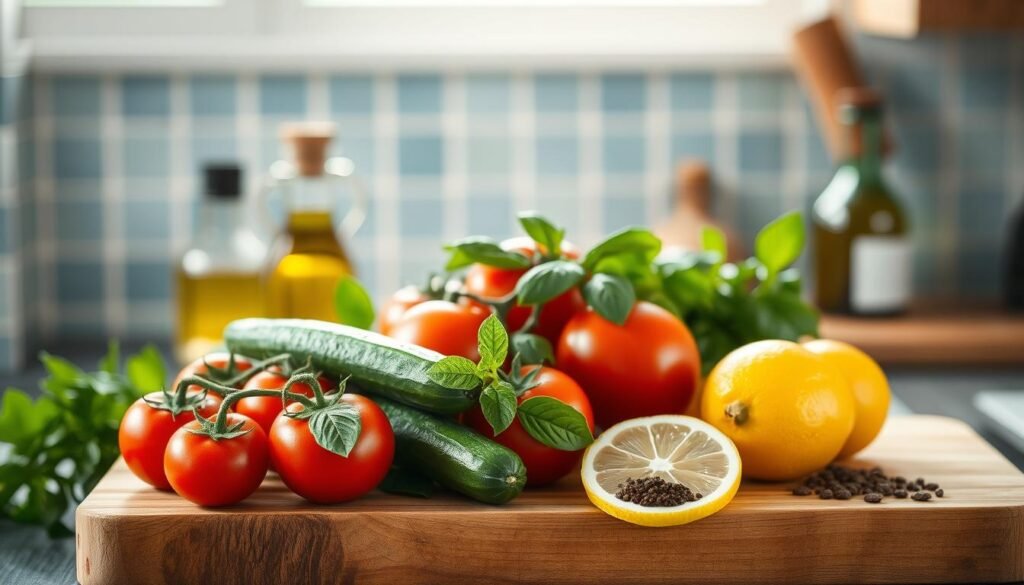
Key Benefits and Nutrient Highlights
At its core, this approach prioritizes plant-based items like crisp greens, juicy tomatoes, and briny olives. Olive oil replaces heavy sauces, while herbs like oregano and mint add zing without salt. Studies link these choices to sharper focus and a 30% lower heart disease risk, according to Harvard research.
| Traditional Diet | Mediterranean Approach | Key Benefit |
|---|---|---|
| Processed snacks | Olives & nuts | Sustained energy |
| Butter-based fats | Extra virgin olive oil | Healthy cholesterol |
| Red meat focus | Fish & legumes | Lean protein sources |
During recipe testing, my team noticed something fascinating: meals built around these elements kept our afternoon energy steady. Chickpeas tossed with roasted peppers and a lemon dressing became a studio favorite—proof that smart combos work harder for your body.
What truly sets this style apart? It’s not about strict rules. It’s about leaning into quality ingredients that do double duty. Crumbled feta adds calcium, while walnuts contribute omega-3s. Every bite delivers flavor and function, making it ideal for busy lives.
Exploring no heat lunchbox meals mediterranean
What if your most flavorful midday break required zero cooking time? During recipe testing for my meal prep classes, I discovered vibrant combinations that thrive at room temperature. Think zesty chickpea salads and tahini-drizzled wraps – dishes designed to taste better as they rest.
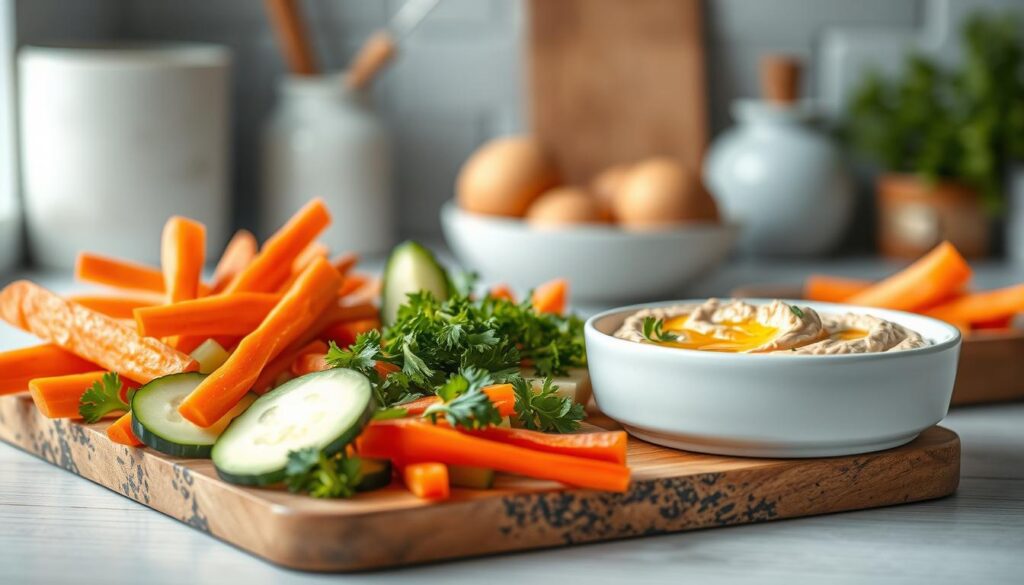
These creations stand apart through smart ingredient pairings. Crunchy cucumbers balance creamy hummus, while lemon juice keeps greens perky for hours. Unlike soggy sandwiches, these textures stay crisp thanks to olive oil’s natural preserving power.
| Traditional Components | Mediterranean Components | Benefit |
|---|---|---|
| Mayo-based spreads | Hummus or tzatziki | Better texture retention |
| Iceberg lettuce | Kale or shredded cabbage | Higher nutrient density |
| Deli meats | Grilled chicken strips | Leaner protein source |
My students love assembling Greek quinoa bowls in 15 minutes flat. Toss pre-cooked grains with cherry tomatoes, feta, and a garlicky yogurt sauce. It’s proof that fast recipes don’t sacrifice flavor or nutrition.
Experiment with bold combinations: roasted red peppers + white beans, or minted farro + grilled zucchini. These ideas adapt to whatever’s in your fridge – the ultimate kitchen magic for time-crunched days. Your taste buds (and schedule) will thank you.
Quick and Refreshing Mediterranean Salad Ideas
What transforms ordinary greens into a lunchtime masterpiece? During my meal prep classes, students consistently rave about salads that stay crisp for hours. The secret lies in bold textures and bright dressings that travel well.
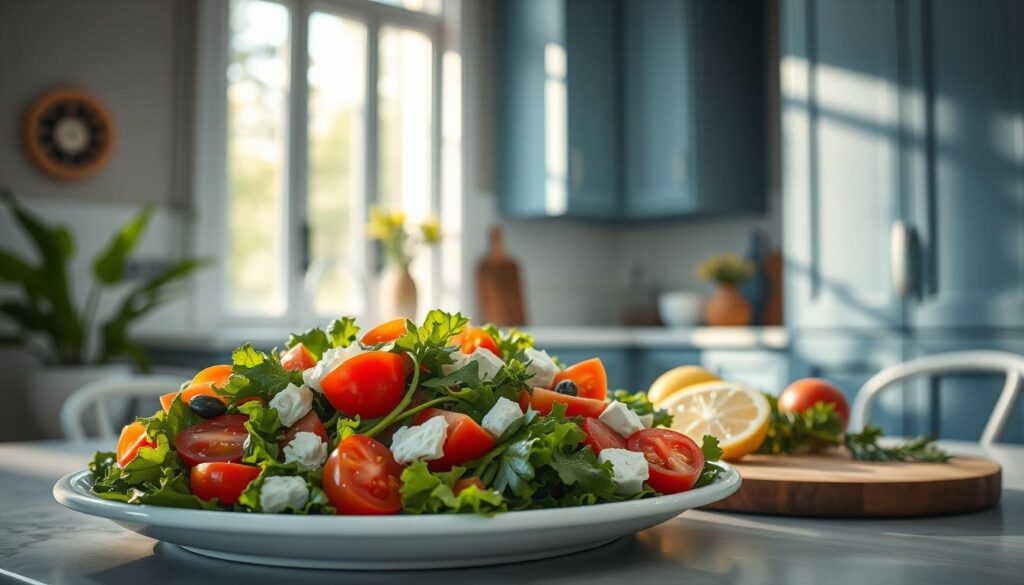
Simple Salad Recipes for Office Lunches
Try this crowd-pleaser: Mediterranean lentil salad with roasted peppers and parsley. Toss cooked lentils with diced cucumbers, sun-dried tomatoes, and a lemon-garlic dressing. It’s ready in 15 minutes and improves overnight as flavors meld.
| Traditional Dressing | Mediterranean Upgrade | Why It Works |
|---|---|---|
| Creamy ranch | Yogurt-tahini blend | Stays emulsified |
| Vinegar-heavy | Lemon-oregano mix | Brightens ingredients |
Creative Twists on Traditional Combinations
Swap romaine for shredded kale massaged with olive oil – it won’t wilt before noon. Add toasted pine nuts for crunch or pomegranate seeds for sweetness. One student’s genius hack? Using marinated artichokes as salad “confetti” for bursts of flavor.
Here’s the kicker: these creations deliver 6-8g of fiber per serving. Pair them with whole-grain crackers or stuffed grape leaves for staying power. Pro tip: pack dressings in reusable squeeze bottles to control portions and prevent sogginess.
Try these combos as springboards:
- Chickpeas + mint + watermelon cubes
- Quinoa + roasted carrots + za’atar
- Spinach + grilled halloumi + orange slices
Protein-Packed Mediterranean Favorites: Chicken, Tuna & More
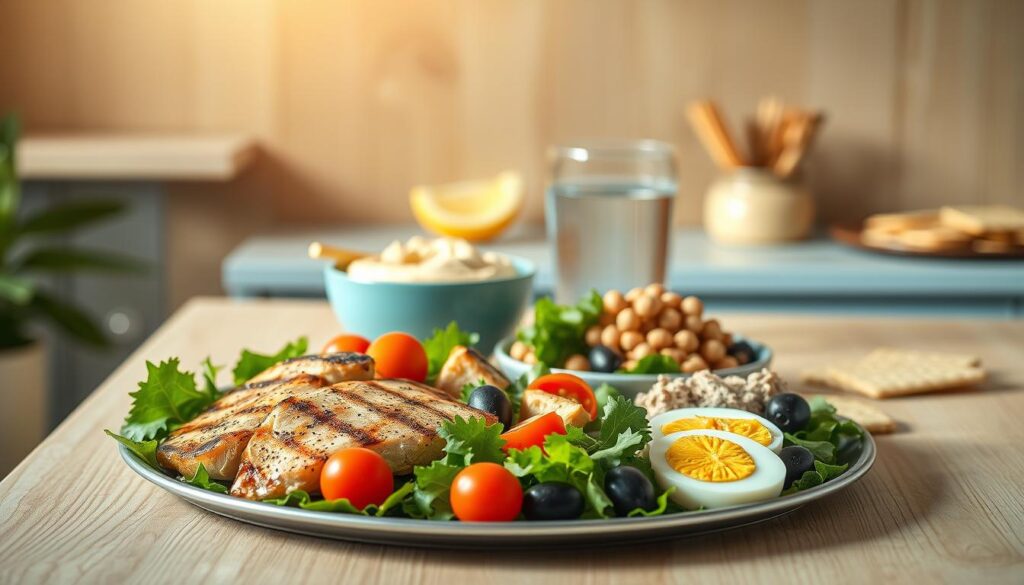
What keeps you energized through afternoon meetings without reheating? During recipe testing for my meal prep classes, students consistently requested hearty options that deliver lasting fuel. The answer lies in smart protein pairings that shine at room temperature.
Innovative Chicken and Tuna Salad Combos
Swap mayo-heavy mixes for bright alternatives. My avocado-tuna mashup combines flaked fish with diced cucumbers and lemon zest – it’s been a hit with busy parents needing quick lunches. For chicken lovers, try shredding rotisserie meat into a basil pesto base with sun-dried tomatoes. These combos prove lean proteins can be both satisfying and refreshing.
| Traditional Protein | Mediterranean Upgrade | Key Benefit |
|---|---|---|
| Canned tuna in oil | Olive oil-poached tuna | Better texture |
| Boiled chicken breast | Herb-marinated grilled chicken | Enhanced flavor |
| Plain white beans | Rosemary-roasted chickpeas | Crunch factor |
Versatile Ingredients That Boost Protein
Sturdy legumes like cannellini beans add plant-based power to grain bowls. Toss them with olive-cured tuna or diced chicken for double protein impact. Crumbled feta or toasted pine nuts provide texture contrast while sneaking in extra nutrients.
One student’s genius hack? Using smashed white beans as a sandwich spread instead of hummus. Paired with lemon-dressed arugula and sliced turkey, it creates a lunch that stays fresh for hours. These flexible formulas let you mix proteins with whatever veggies need using up – reducing waste while maximizing flavor.
Grains and Pasta with a Mediterranean Twist
Grains transform lunchboxes into texture playgrounds when treated right. During my meal prep workshops, students light up when discovering how chilled orzo or farro keeps its chew for days. These staples become flavor carriers, absorbing zesty dressings while maintaining structure.
Smart Foundations for Satisfying Meals
Whole-wheat pasta and quinoa shine in cold preparations. Toss them with roasted vegetables or briny olives for instant depth. My team calls this approach “grain alchemy” – turning simple bases into crave-worthy creations.
| Traditional Grain Use | Mediterranean Upgrade | Why It Works |
|---|---|---|
| Plain white rice | Lemon-herb quinoa | Higher protein & fiber |
| Buttered noodles | Whole-wheat pasta salad | Better texture retention |
| Instant couscous | Toasted pearl couscous | Nutty flavor boost |
Time-saving tip: Cook grains in big batches Sunday night. Portion into containers with:
- Chopped cucumbers
- Crumbled feta
- Marinated artichokes
“Fresh dill or mint transforms leftover grains into something special – it’s like hitting the refresh button on your lunch.”
Try this crowd-pleaser: toss cooled whole-wheat rotini with sun-dried tomatoes, chickpeas, and a garlicky yogurt dressing. It’s become a studio favorite for its balance of bright flavors and staying power. The best part? These dishes often taste better on day two as ingredients mingle.
Creative Mediterranean Wraps, Pitas and Tacos
What’s better than a sandwich that stays crisp and fresh until lunchtime? During my meal prep workshops, students consistently request handheld options that won’t turn soggy. The solution lies in smart assembly techniques perfected across coastal kitchens.
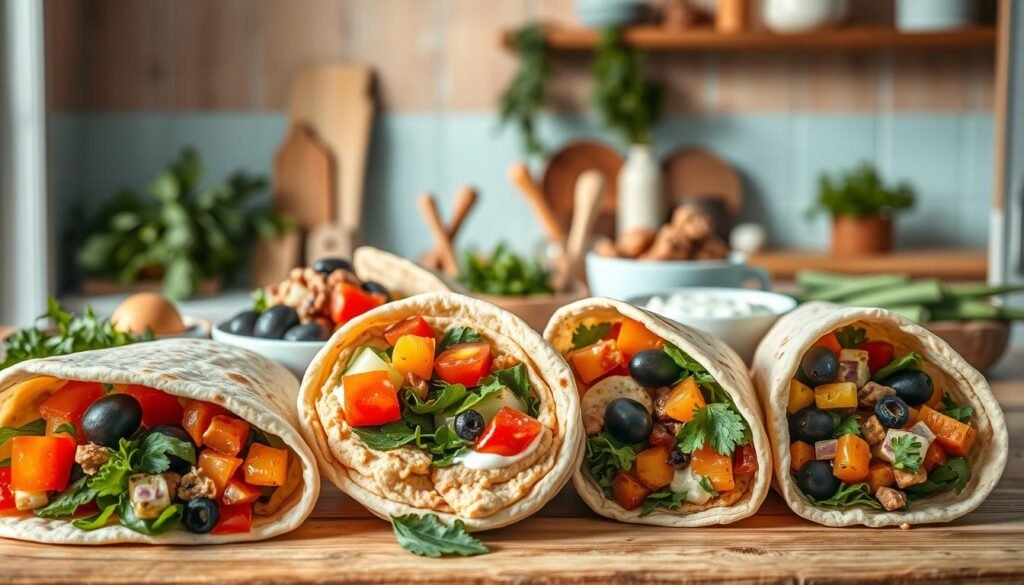
Easy Assembly for On-the-Go Lunch Options
Swap bread slices for whole-grain pita pockets – their sturdy structure holds up to bold fillings. My go-to formula: spread hummus inside, layer shredded rotisserie chicken, then add crunchy veggies. Top with avocado slices for creaminess that replaces mayo-based spreads.
| Traditional Wrap | Mediterranean Upgrade | Advantage |
|---|---|---|
| Flour tortilla | Whole-wheat lavash | Higher fiber |
| Lettuce base | Massaged kale | Wilt-resistant |
| Deli meat | Za’atar-spiced turkey | Bolder flavor |
One student’s genius hack? Use collard greens as taco shells. Fill them with quinoa tabbouleh and feta for a gluten-free option that travels well. Prep components Sunday night – you’ll assemble lunches in minutes all week.
Try these combos:
- Smoked salmon + dill yogurt + cucumber ribbons in pita
- Chickpea salad + pickled onions + tahini in flatbread
- Grilled halloumi + roasted peppers + arugula in lavash
Pro tip: Wrap creations in parchment paper first, then foil. The paper prevents sogginess while keeping flavors vibrant until your midday break.
Budget-Friendly Mediterranean Lunch Options
Eating well shouldn’t drain your wallet or time. As a chef testing recipes for families, I’ve found smart swaps that keep costs under $3 per serving while delivering bold flavors. The trick? Building around pantry staples and seasonal produce that packs nutritional punch.
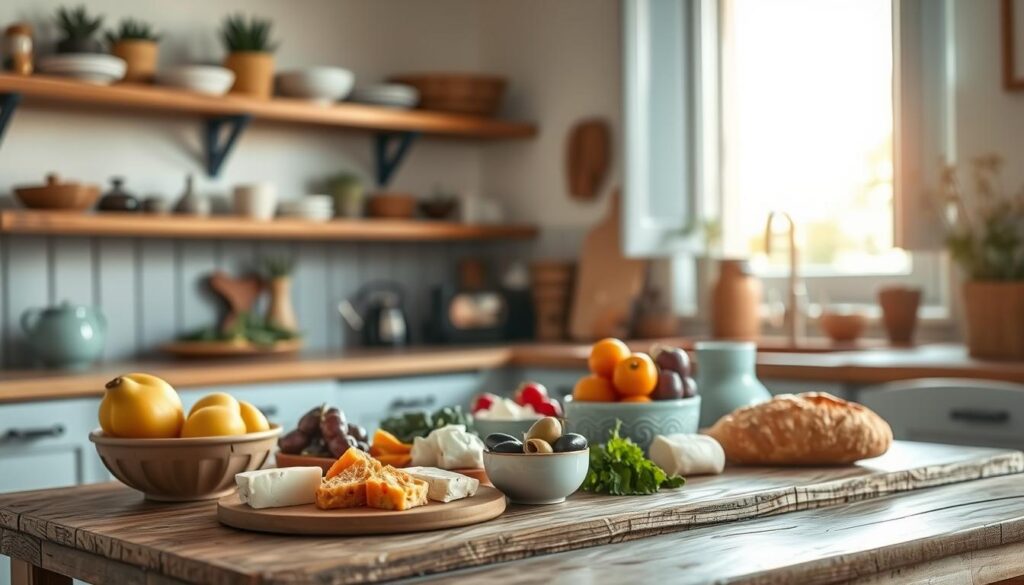
Start with versatile bases like bulgur wheat or canned beans – they’re affordable and shelf-stable. Pair them with in-season veggies for freshness without markup. One reader favorite: roasted carrot and lentil bowls with tahini drizzle. Prep four portions in 30 minutes for under $10 total.
| Traditional Ingredient | Budget-Friendly Swap | Cost Savings |
|---|---|---|
| Imported feta | Domestic ricotta salata | 40% less |
| Fresh herbs | Dried oregano/mint | 75% less |
| Pre-cut veggies | Whole produce | $2-3 per lb saved |
Batch cooking transforms your week. Sunday prep sessions let you repurpose ingredients across multiple days. Simmer a big pot of chickpeas – use them in salads, wraps, and grain bowls. Freeze extras for future recipes.
“Frozen spinach and citrus zest can elevate simple dishes without breaking the bank.”
Try these wallet-friendly ideas:
- Spiced chickpea pitas with yogurt sauce
- Zucchini ribbon pasta with lemon-herb dressing
- Roasted beet and barley salad
Smart planning cuts food waste and grocery bills. Focus on 3-4 core ingredients each week, then mix textures and flavors through spices and dressings. Your midday break stays exciting while keeping cash in your pocket.
No-Heat Preparation Techniques for Busy Days
Ever felt like morning kitchen chaos steals your day’s momentum? Let’s flip the script. After years of testing strategies with time-crunched families, I’ve found smart prep turns hectic mornings into smooth operations. Start with a Sunday reset: wash greens, chop sturdy veggies, and batch-cook grains. These foundations let you assemble lunches faster than ordering takeout.
Streamlining Your Kitchen Routine
Focus on components that work overtime. Pre-cut bell peppers become salad stars, wrap fillers, and grain bowl toppers. Store them in glass jars with olive oil and herbs for instant flavor infusion. Dressings? Whisk big batches using pantry staples – lemon juice, oil, and dried oregano create endless versatility.
| Traditional Prep | Streamlined Approach | Time Saved |
|---|---|---|
| Daily chopping | Batch-cut Sundays | 15 min/day |
| Last-minute dressing | Pre-mixed jars | 5 min/meal |
| Separate containers | Layered jars | 7 min/pack |
My students swear by the “flavor station” method. Keep prepped ingredients in clear bins labeled “crunchy,” “creamy,” and “zippy.” Need spicy chickpea wraps? Grab from each category and roll. This system cuts assembly time to under 5 minutes while keeping flavors bold.
“Organization isn’t about perfection – it’s about creating visual cues that make healthy choices effortless.”
Remember: oil-based dressings prevent wilting better than water-heavy sauces. Pair them with hearty greens like kale or shredded cabbage. Your future self will thank you when lunch stays fresh until that 1 PM meeting.
Enhancing Flavors with Fresh Ingredients & Dressings
A great dressing turns basic ingredients into something memorable—no cooking required. During my meal prep classes, students often share how a simple sauce transforms their midday meals from bland to bold. Let’s explore how homemade blends elevate textures and tastes while staying fresh for hours.
Homemade Dressings That Elevate Taste
Fresh herbs like basil and dill add vibrancy to olive oil-based mixes. Pair them with ripe tomatoes or citrus zest for brightness. A tahini-lemon blend becomes creamy without dairy, while Greek yogurt creates tangy bases for veggie dips.
| Store-Bought Dressing | Homemade Upgrade | Flavor Impact |
|---|---|---|
| High in preservatives | Fresh ingredients | Brighter taste |
| Generic flavors | Customizable herbs | Personalized zing |
| Separates quickly | Emulsified texture | Consistent coating |
Crumbled feta or goat cheese balances zesty dressings beautifully. Try this combo: whisk oregano, garlic, and red wine vinegar into olive oil. Drizzle over roasted vegetables for depth that improves overnight.
“The right dressing ratio? Three parts oil to one part acid—adjust based on your ingredients’ boldness.”
Store dressings in small jars with tight lids. Layer them under grains or proteins to prevent sogginess. For best results, shake containers before eating to redistribute flavors evenly.
Diet-Inclusive Mediterranean Recipes: Gluten-Free, Vegan, and More
Inclusive eating starts with flexible formulas. During recipe testing for allergy-conscious families, I discovered how simple swaps can make classic dishes work for nearly any diet. The key? Focusing on bold flavors that transcend ingredients lists.
Adapting Recipes to Suit Your Dietary Needs
Take my popular lemon-herb chicken salad. For dairy-free versions, hummus replaces mayo, adding creaminess without animal products. Vegan readers love using mashed lentils instead of tuna – their earthy flavor pairs perfectly with capers and diced celery.
| Traditional Ingredient | Diet-Friendly Swap | Benefit |
|---|---|---|
| Feta cheese | Marinated tofu cubes | Vegan protein boost |
| Pita bread | Lettuce wraps | Gluten-free crunch |
| Yogurt sauce | Tahini-lemon blend | Nut-free option |
Beans become secret weapons here. White bean spread mimics ricotta in stuffed peppers, while chickpea flour creates crispy flatbreads. One student’s genius hack: using mashed cannellini beans as a gluten-free binder in veggie patties.
“My gluten-sensitive daughter now requests ‘special’ lentil-stuffed grape leaves weekly – they’re her favorite lunchbox surprise.”
Experiment with texture contrasts. Toasted walnuts add crunch to vegan grain bowls, while roasted red peppers bring sweetness to dairy-free dishes. Keep dressings versatile: a basic lemon-olive oil mix works across dietary needs, letting you customize with herbs or spices.
Mediterranean Meal Prepping: Storage and Lunchbox Tips
How do you keep prepped ingredients tasting fresh by Friday? Through years of testing, I’ve found smart storage makes all the difference. Start with airtight glass containers – they lock in flavors better than plastic. Layer grains at the bottom, proteins in the middle, and delicate greens on top. This “sandwich method” prevents sogginess while letting flavors mingle.
Portioning is key for busy schedules. Sundays, I divide cooked quinoa and roasted veggies into five containers. Add marinated beans or chickpeas daily to maintain texture. Pro tip: Freeze dressings in silicone cubes for grab-and-go convenience.
| Container Type | Best For | Why It Works |
|---|---|---|
| Glass jars | Layered salads | Prevents crushing |
| Bento boxes | Portion control | Separates components |
| Reusable pouches | Dressings/dips | Leak-proof design |
Chickpeas shine in make-ahead dishes. Toss them with olive oil and paprika before storing – they’ll stay crisp for three days. One reader’s genius hack: Use muffin tins to portion hummus cups for the week.
“Proper storage turns meal prep from a chore into a strategy – your future self will high-five you every noon.”
Build a system that fits your rhythm. Maybe Wednesday night is your “refresh” session – add fresh herbs or citrus zest to prepped bases. Consistency beats perfection every time.
Transforming your midday meal doesn’t require a kitchen or a microwave—just smart prep and bold flavors. As we’ve explored, vibrant salads, protein-rich bowls, and zesty wraps prove that eating well on the go can be both simple and satisfying. Whether you’re packing a lemony chicken salad or a chickpea-stuffed pepper, these recipes keep textures crisp and nutrients intact.
Through years of testing recipes with busy families, I’ve seen how flexible formulas like tuna salad with avocado or Greek-inspired grain bowls become weekday heroes. They’re designed to adapt: swap greens based on what’s fresh, or mix roasted peppers into hummus for extra crunch. The best part? Every combo delivers the bright, fresh tastes you’d expect from coastal-inspired cooking.
Ready to rethink your routine? Try a quinoa bowl with grilled veggies or a minty chickpea salad—dishes that stay flavorful for hours. Share your creations online using #FreshNoHeatEats, and let’s build a community around hassle-free, delicious midday breaks. After all, great food shouldn’t wait for a microwave.
Mediterranean Sardine & Lentil Grain Bowl
A nourishing and flavorful Mediterranean-inspired grain bowl featuring protein-rich lentils, hearty grains, and savory sardines, complemented by fresh vegetables and a zesty dressing.
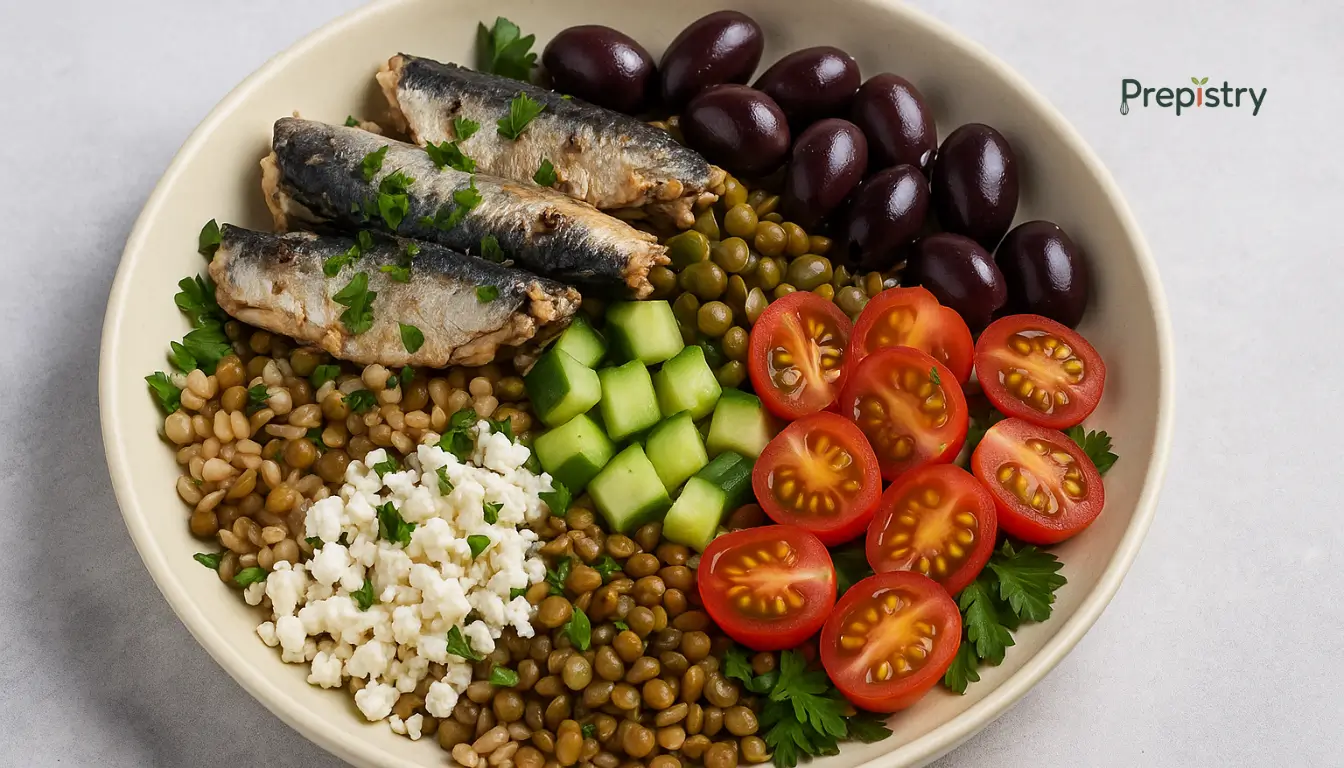
Nutrition Information
Equipment Needed
- Saucepan
- Skillet
- Mixing bowls
- Serving bowls
- Knife
- Cutting board
Ingredients
-
1 cup brown lentils, rinsed
-
2 cups water
-
1 cup cooked farro or quinoa
-
2 tablespoons olive oil
-
1 medium zucchini, sliced
-
1/2 red onion, diced
-
1 cup cherry tomatoes, halved
-
1/4 cup kalamata olives, pitted and sliced
-
2 tablespoons fresh parsley, chopped
-
1 tablespoon lemon juice
-
Salt and pepper to taste
-
4 sardine fillets, packed in olive oil
-
1/4 cup crumbled feta cheese (optional)
Instructions
Recipe Video
Mediterranean Sardine & Lentil Grain Bowl Recipe
Learn how to prepare a delicious and healthy Mediterranean Sardine & Lentil Grain Bowl, perfect for a nutritious meal.

